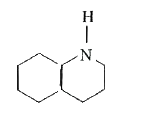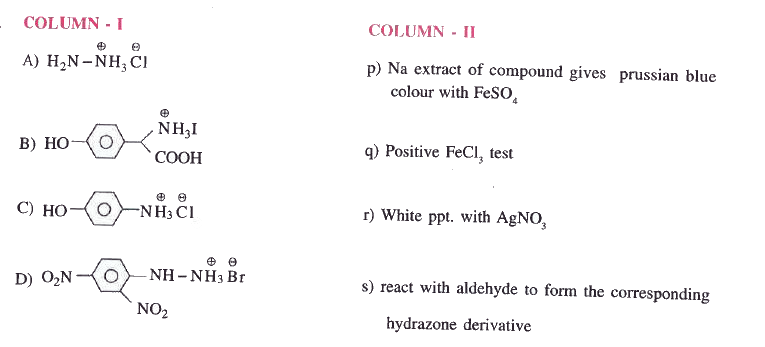An organic compound ‘A’ has molecular formula C9H13NO and it can be resolve into enantiomers. Adoes not decolourise bromine water solution. A on refluxing with dilute H2SO4, yields another revolvable compound B(C9H14O3) which give effervescence with NaHCO3. B on treatment with NaBH4 yields C(C9H16O3) on heating with concentrated H2SO4 yields ester D (C6H14O2).
Compound A on reduction with LiAlH4 followed by treatment of H2SO4 yields following compound :

Due to reduction of optically pure 'B'two isomeric product 'C' form. Isomeric product 'C' are :Solution in Telugu
Enantiomers
Diastereomers
Position isomers
Functional isomers
The correct Answer is:B
Topper's Solved these Questions
- AMINES AND AZO COMPOUNDS BOOK - AAKASH SERIESCHAPTER - AMINES AND AZO COMPOUNDS EXERCISE - PRACTICE SHEET - 6 (Linked Comprehension type questions) Passage - II
3 Videos
- AMINES AND AZO COMPOUNDS BOOK - AAKASH SERIESCHAPTER - AMINES AND AZO COMPOUNDS EXERCISE - PRACTICE SHEET - 6 (Match the following questions)
2 Videos
- AMINES AND AZO COMPOUNDS BOOK - AAKASH SERIESCHAPTER - AMINES AND AZO COMPOUNDS EXERCISE - PRACTICE SHEET - 6 (More than one correct answer)
4 Videos
- ALKYL AND ARYL HALIDESBOOK - AAKASH SERIESCHAPTER - ALKYL AND ARYL HALIDESEXERCISE - OBJECTIVE EXERCISE - 4 (ASSERTION (A) & REASON (R) TYPE QUESTIONS)
19 Videos
- AMINES AND DIAZONIUM SLATSBOOK - AAKASH SERIESCHAPTER - AMINES AND DIAZONIUM SLATSEXERCISE - PRACTICE EXERCISE
25 Videos
Similar Questions
when an primay aromatic amine is treated with NaNO2+HCl at 00−50C, a diazonium salt is formed and the reaction is called diazo reaction. In this reaction mineral acid must be added to prevent the coupling reaction of diazonium salt with excess of aryl amine. Diazonium salt is highly useful in the synthesis of number of coloured dyes.
For the following diazonium ion the decreasing order of reactivity of these ion in azo-coupling rcaction

View SolutionMatch the following

View SolutionWhich of the following amine(s) after diazotization will form deeply coloured azodye with alkaline solution of β-naphthol :
View Solution(A) Towards SN2 reaction, order of reactivity is CH3Br>CH3CH2Br>(CH3)2CHBr>(CH3)3CBr.
(R) Greater the stability of carbocation, greater will be its ease of formation from alkyl halide and faster will be the rate of SN1 reaction.
View SolutionIUPAC name of (C2H5)3C−NH2 is
View SolutionA compound with the formula C_(4)H_(10)O yields another compound C_(4)H_(8)O , on heating with K_(2)Cr_(2)O_(7) and H_(2)SO_(4) . The compound C_(4)H_(10)O is expected to be
View SolutionAn organic compound A has molecular formula C10H17Br and it is non-resolvable. A does not decolourize brown colour of bromine water solution. A on treatement with (CH3)2COK/(CH3)3COH yields B as majot product. B on treatment with H2/Pt yields (C10H16) which on treatment with CI2/hv yields three monochloro derivative. Also B on boiling with acidic permanganate solution yields C(C10H16O3)C. on heating with sodalime yields D(C9H16O).D on reducing with LiAIH4 followed yields C(C10H16O3).C on heating with sodalime yields D(C9H16O).D on reducing with LiAIH4 followed by heating product with concentrated H2SO4 yields E(C9H16) as major product. E on treatment with ozone followed by work-up with Zn−H2O yields 6-Ketononanal.
Compound A is:
View SolutionAn organic compound A has molecular formula C10H17Br and it is non-resolvable. A does not decolourize brown colour of bromine water solution. A on treatement with (CH3)2COK/(CH3)3COH yields B as majot product. B on treatment with H2/Pt yields (C10H16) which on treatment with CI2/hv yields three monochloro derivative. Also B on boiling with acidic permanganate solution yields C(C10H16O3)C. on heating with sodalime yields D(C9H16O).D on reducing with LiAIH4 followed yields C(C10H16O3).C on heating with sodalime yields D(C9H16O).D on reducing with LiAIH4 followed by heating product with concentrated H2SO4 yields E(C9H16) as major product. E on treatment with ozone followed by work-up with Zn−H2O yields 6-Ketononanal.
Compound B is:
View SolutionAn organic compound A has molecular formula C10H17Br and it is non-resolvable. A does not decolourize brown colour of bromine water solution. A on treatement with (CH3)2COK/(CH3)3COH yields B as majot product. B on treatment with H2/Pt yields (C10H16) which on treatment with CI2/hv yields three monochloro derivative. Also B on boiling with acidic permanganate solution yields C(C10H16O3)C. on heating with sodalime yields D(C9H16O).D on reducing with LiAIH4 followed yields C(C10H16O3).C on heating with sodalime yields D(C9H16O).D on reducing with LiAIH4 followed by heating product with concentrated H2SO4 yields E(C9H16) as major product. E on treatment with ozone followed by work-up with Zn−H2O yields 6-Ketononanal.
Compound C is:
View SolutionAn organic compound A has molecular formula C10H17Br and it is non-resolvable. A does not decolourize brown colour of bromine water solution. A on treatement with (CH3)2COK/(CH3)3COH yields B as majot product. B on treatment with H2/Pt yields (C10H16) which on treatment with CI2/hv yields three monochloro derivative. Also B on boiling with acidic permanganate solution yields C(C10H16O3)C. on heating with sodalime yields D(C9H16O).D on reducing with LiAIH4 followed yields C(C10H16O3).C on heating with sodalime yields D(C9H16O).D on reducing with LiAIH4 followed by heating product with concentrated H2SO4 yields E(C9H16) as major product. E on treatment with ozone followed by work-up with Zn−H2O yields 6-Ketononanal.
Compound D is:
View SolutionAn organic compound 'A' has molecular formula C_(9)H_(13)NO and it can be resolved into enatiomers. A does not decolourise bromine water solution. A on reflxing with dilute H_(2)SO_(4) yields another resolable compound B(C_(9)H_(14)O_(3)) which gives effervescence with NaHCO_(3) . B on treatemet with NaBH_(4) yields C(C_(9)H_(16)O_(3)) on heating with concentrated H_(2)O_(4) yields ester D(C_(9)H_(14)O_(2)) . Compound A on reduction with LiAIH_(4) , followed by treatement of H_(2)SO_(4) yields following compound: Find out structure of compound 'A' :
View SolutionAn organic compound 'A' has molecular formula C_(9)H_(13)NO and it can be resolved into enatiomers. A does not decolourise bromine water solution. A on reflxing with dilute H_(2)SO_(4) yields another resolable compound B(C_(9)H_(14)O_(3)) which gives effervescence with NaHCO_(3) . B on treatemet with NaBH_(4) yields C(C_(9)H_(16)O_(3)) on heating with concentrated H_(2)O_(4) yields ester D(C_(9)H_(14)O_(2)) . Compound A on reduction with LiAIH_(4) , followed by treatement of H_(2)SO_(4) yields following compound: The sweet smelling neutral compound D is:
View SolutionAn organic compound 'A' has molecular formula C_(9)H_(13)NO and it can be resolved into enatiomers. A does not decolourise bromine water solution. A on reflxing with dilute H_(2)SO_(4) yields another resolable compound B(C_(9)H_(14)O_(3)) which gives effervescence with NaHCO_(3) . B on treatemet with NaBH_(4) yields C(C_(9)H_(16)O_(3)) on heating with concentrated H_(2)O_(4) yields ester D(C_(9)H_(14)O_(2)) . Compound A on reduction with LiAIH_(4) , followed by treatement of H_(2)SO_(4) yields following compound: Due to reduction of optically pure 'B' two isomeric product 'C' form. Isomeric product 'C' are:
View SolutionAn organic compound ‘A’ has molecular formula C9H13NO and it can be resolve into enantiomers. Adoes not decolourise bromine water solution. A on refluxing with dilute H2SO4, yields another revolvable compound B(C9H14O3) which give effervescence with NaHCO3. B on treatment with NaBH4 yields C(C9H16O3) on heating with concentrated H2SO4 yields ester D (C6H14O2).
Compound A on reduction with LiAlH4 followed by treatment of H2SO4 yields following compound :

Find out structure of compound 'A''
View SolutionAn organic compound ‘A’ has molecular formula C_(9)H_(13)NO and it can be resolve into enantiomers. Adoes not decolourise bromine water solution. A on refluxing with dilute H_(2)SO_(4) , yields another revolvable compound B(C_(9)H_(14)O_(3)) which give effervescence with NaHCO_(3) . B on treatment with NaBH_(4) yields C(C_(9)H_(16)O_(3)) on heating with concentrated H_(2)SO_(4) yields ester D (C_(6)H_(14)O_(2)) . Compound A on reduction with LiAlH_(4) followed by treatment of H_(2)SO_(4) yields following compound : The sweet smelling neutral compound D is
View Solution
